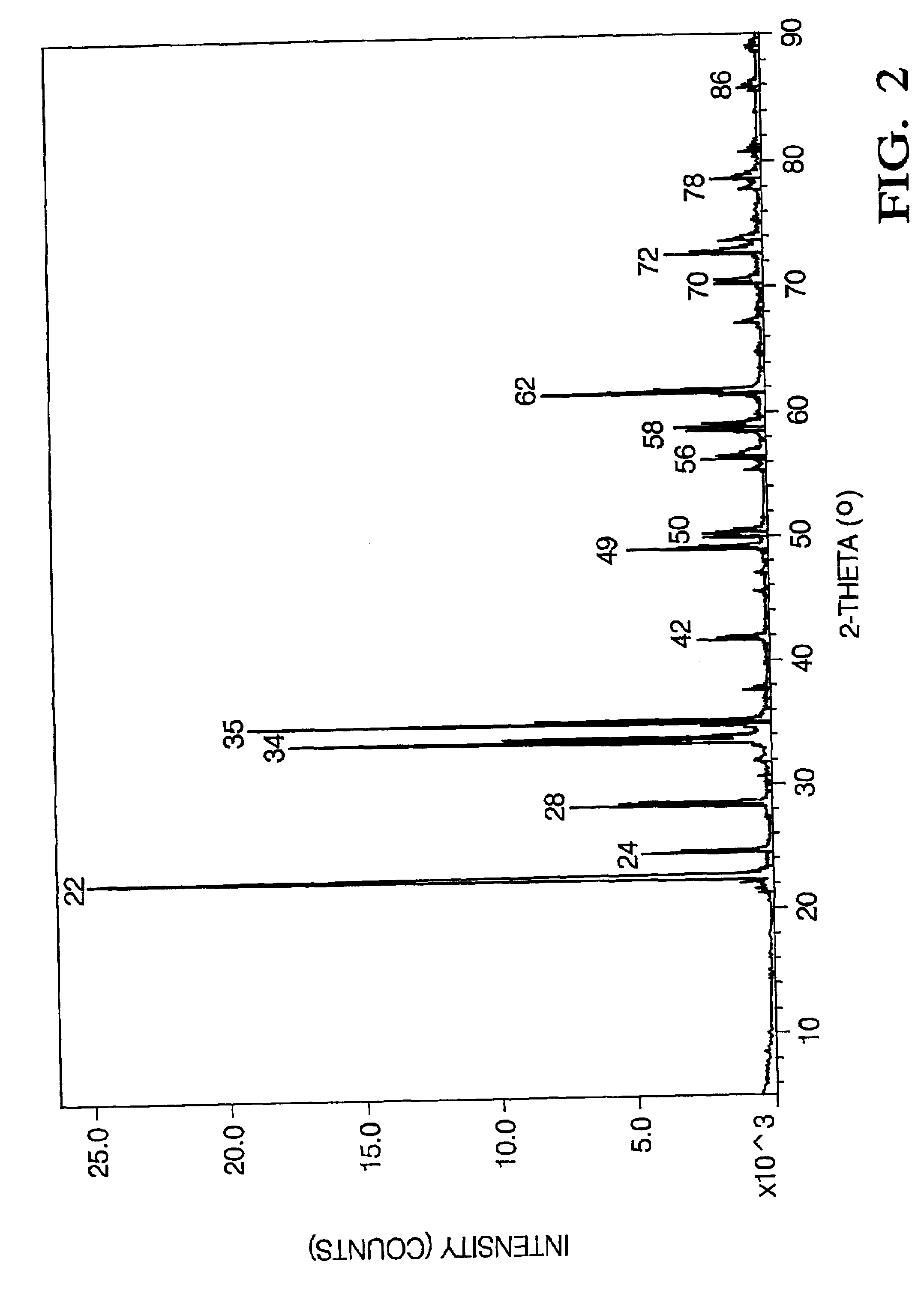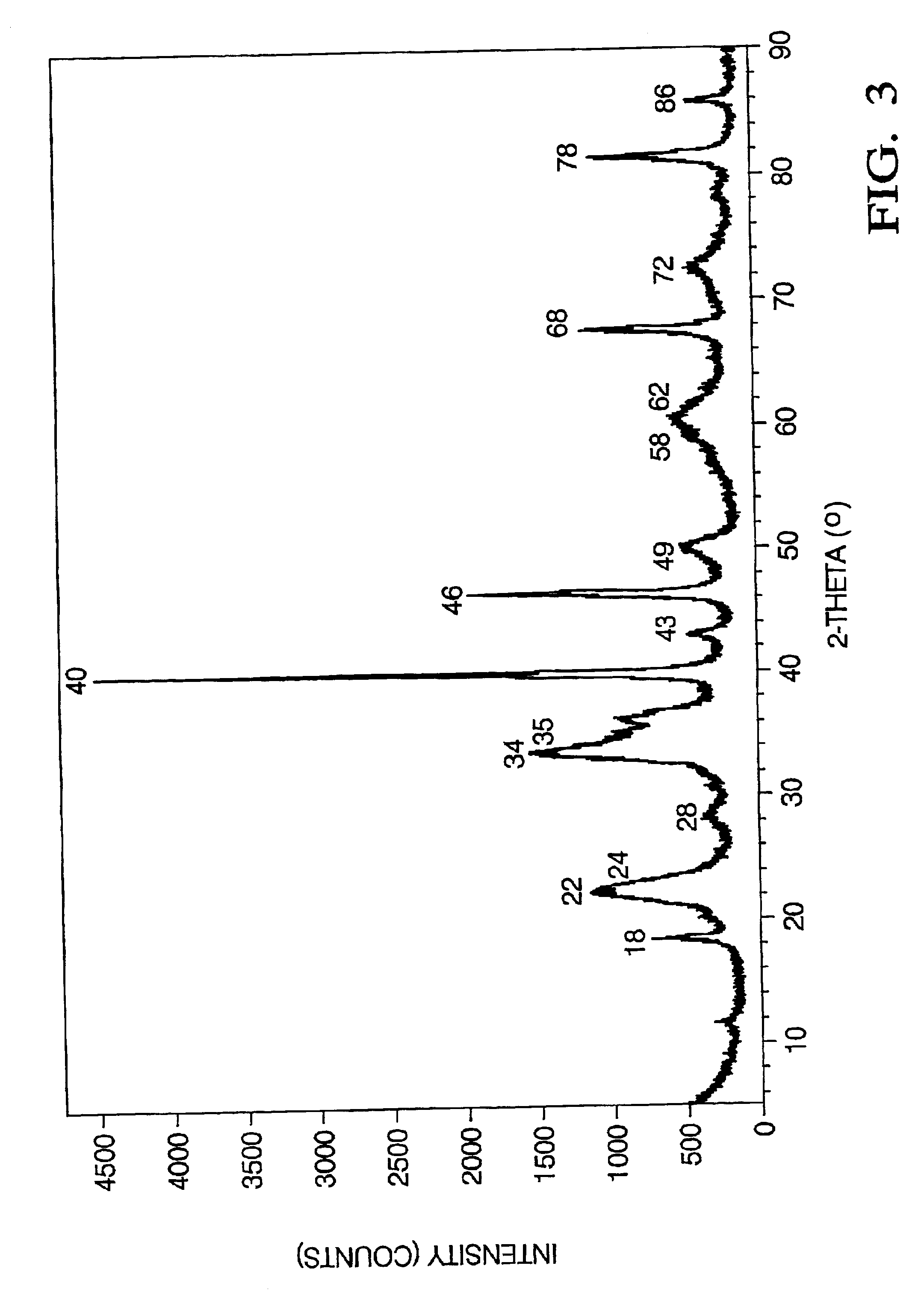Catalyst for the combustion of diesel soot, methods for making the catalyst and methods of using the catalyst
a technology for diesel soot and catalyst, which is applied in the direction of metal/metal-oxide/metal-hydroxide catalyst, silicate, arsenic compound, etc., can solve the problems of significant loss of adhesion of catalyst, lack of durability, and high mobility, and achieve uniform dispersion of catalytic metal and effective catalyst
- Summary
- Abstract
- Description
- Claims
- Application Information
AI Technical Summary
Benefits of technology
Problems solved by technology
Method used
Image
Examples
example 1
Formation of Alkali Metal Aluminate Precursor
To form the alkali metal aluminate precursor, 1.0 mole of lithium hydroxide, 1.0 mole of aluminum hydroxide, and 2 moles of triethanolamine (TEA) were mixed in a 1 L (liter) round-bottom flask with 0.7 L of ethylene glycol as a solvent. The mixture was distilled for a time sufficient to produce a clear yellow solution or sol. The yellowish solution or sol is referred to as the alkali metal aluminate precursor.
To verify the presence of the alkali metal aluminate precursor, the precursor was calcined at 650.degree. C. The presence of alkali metal aluminate was confirmed by x-ray diffraction. FIG. 2 shows the x-ray diffraction data for lithium aluminate. The peaks corresponding the lithium aluminate are labeled and further listed in Table 1.
example 2
First Formation of the Alkali Metal Catalytic Metal Oxide (Black Powder)
500 g of the alkali metal aluminate precursor solution with 20 wt % of volatile free solid or sol was then mixed with 58.3 g of aqueous platinum nitrate solution (12 wt % of Pt). The resulting viscous mixture was then poured into a ceramic calcination dish and put into a calcination furnace. The temperature was ramped at 5.degree. C. / min until it reached 150.degree. C. The mixture was then incubated for 3 hours to remove the unreacted TEA. The temperature was then increased to 400.degree. C. for 2 hours to decompose the metal triethanolamine complexes. The temperature was then increased to 540.degree. C. for 4 hours. A powder with metallic shining black color was obtained. X-ray diffraction of the black powder indicates the presence of poorly crystallized LiAlO.sub.2, Li.sub.2 PtO.sub.3 and metallic Pt. FIG. 3 shows the x-ray diffraction data for the black powder containing lithium aluminate (LiAlO.sub.2), lithi...
example 3
Second Formation of the Alkali Metal Catalytic Metal Oxide (Yellow Powder)
The black powder from Example 2 was then calcined at 800.degree. C. for 16 hours. The resulting powder was bright yellow. X-ray diffraction indicates the presence of LiAlO.sub.2 and Li.sub.2 PtO.sub.3 with only sharp diffraction lines indicating the presence of well-defined crystals. The metallic Pt present in the black powder disappeared. FIG. 4 shows x-ray diffraction data for lithium aluminate (LiAlO.sub.2) and lithium platinum oxide (LiPtO.sub.3). The peaks corresponding to lithium aluminate (LiAlO.sub.2) and lithium platinum oxide (LiPtO.sub.3) are labeled in FIG. 4 and listed in Table 1.
PUM
| Property | Measurement | Unit |
|---|---|---|
| melting points | aaaaa | aaaaa |
| melting points | aaaaa | aaaaa |
| pressure drop | aaaaa | aaaaa |
Abstract
Description
Claims
Application Information
 Login to View More
Login to View More - R&D
- Intellectual Property
- Life Sciences
- Materials
- Tech Scout
- Unparalleled Data Quality
- Higher Quality Content
- 60% Fewer Hallucinations
Browse by: Latest US Patents, China's latest patents, Technical Efficacy Thesaurus, Application Domain, Technology Topic, Popular Technical Reports.
© 2025 PatSnap. All rights reserved.Legal|Privacy policy|Modern Slavery Act Transparency Statement|Sitemap|About US| Contact US: help@patsnap.com



